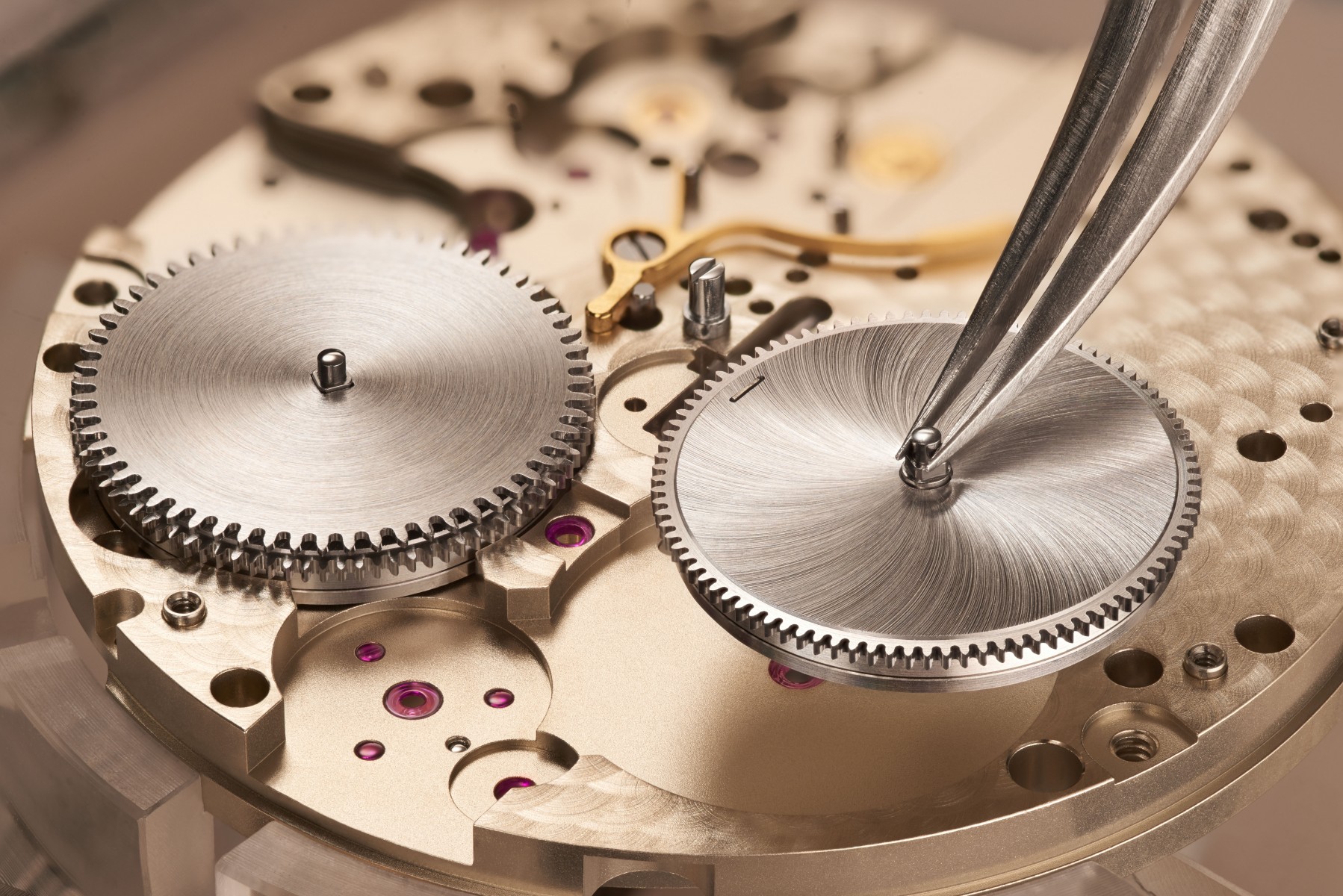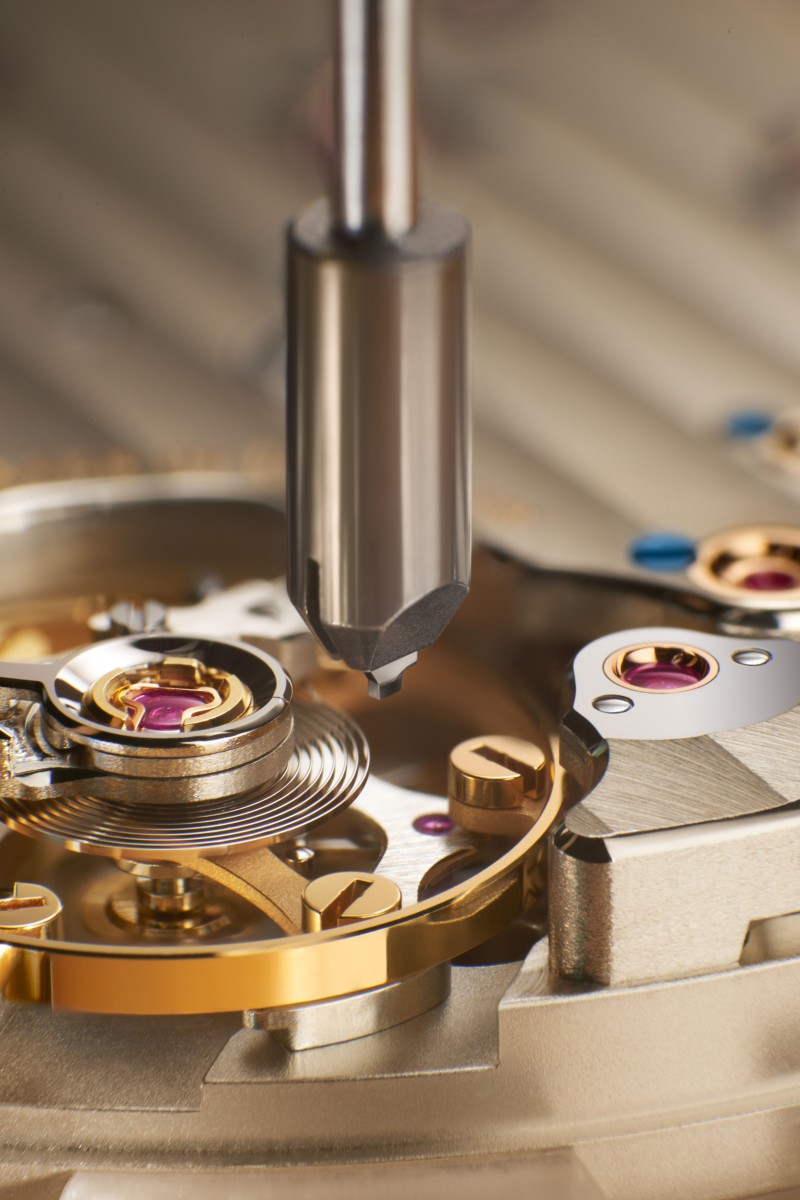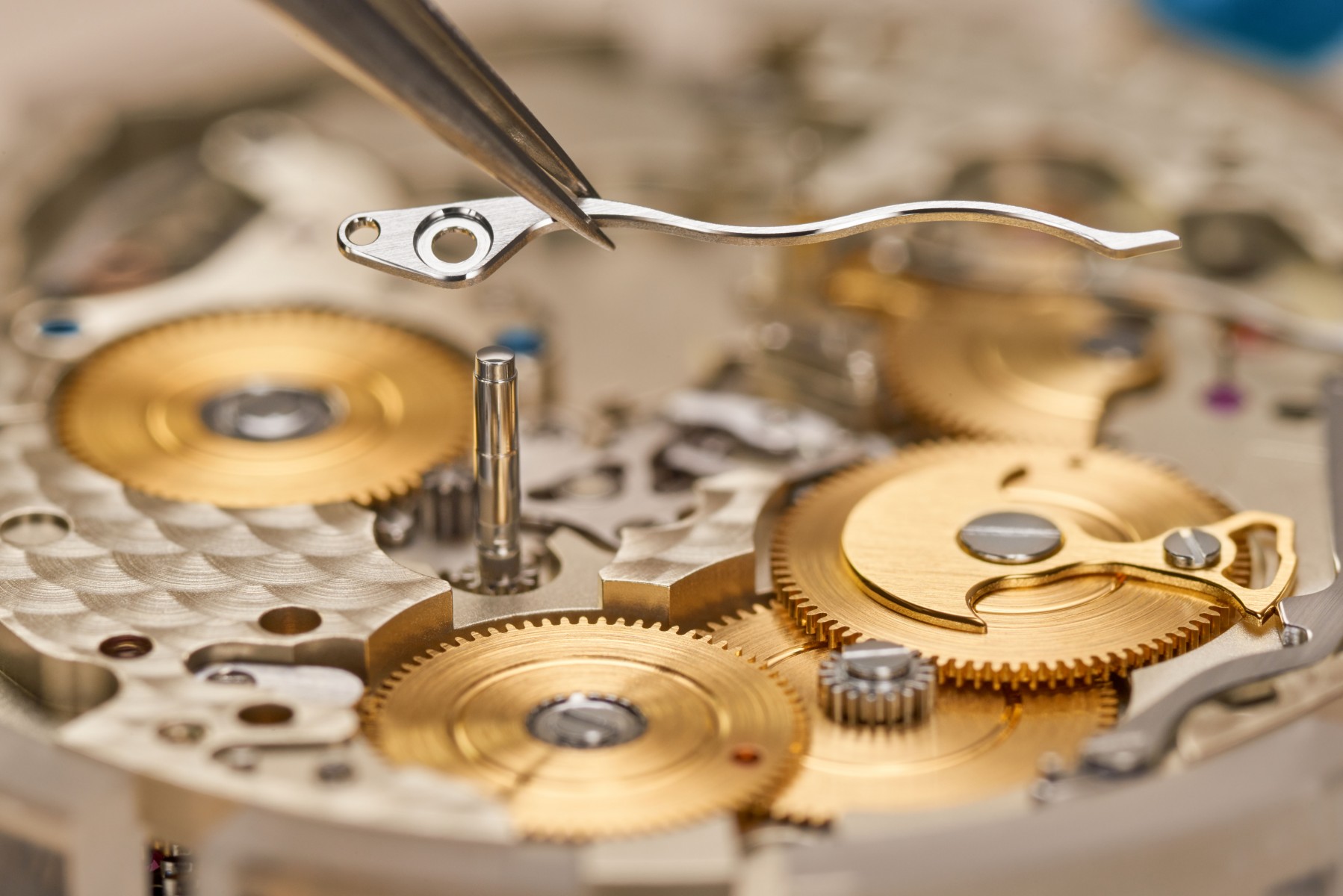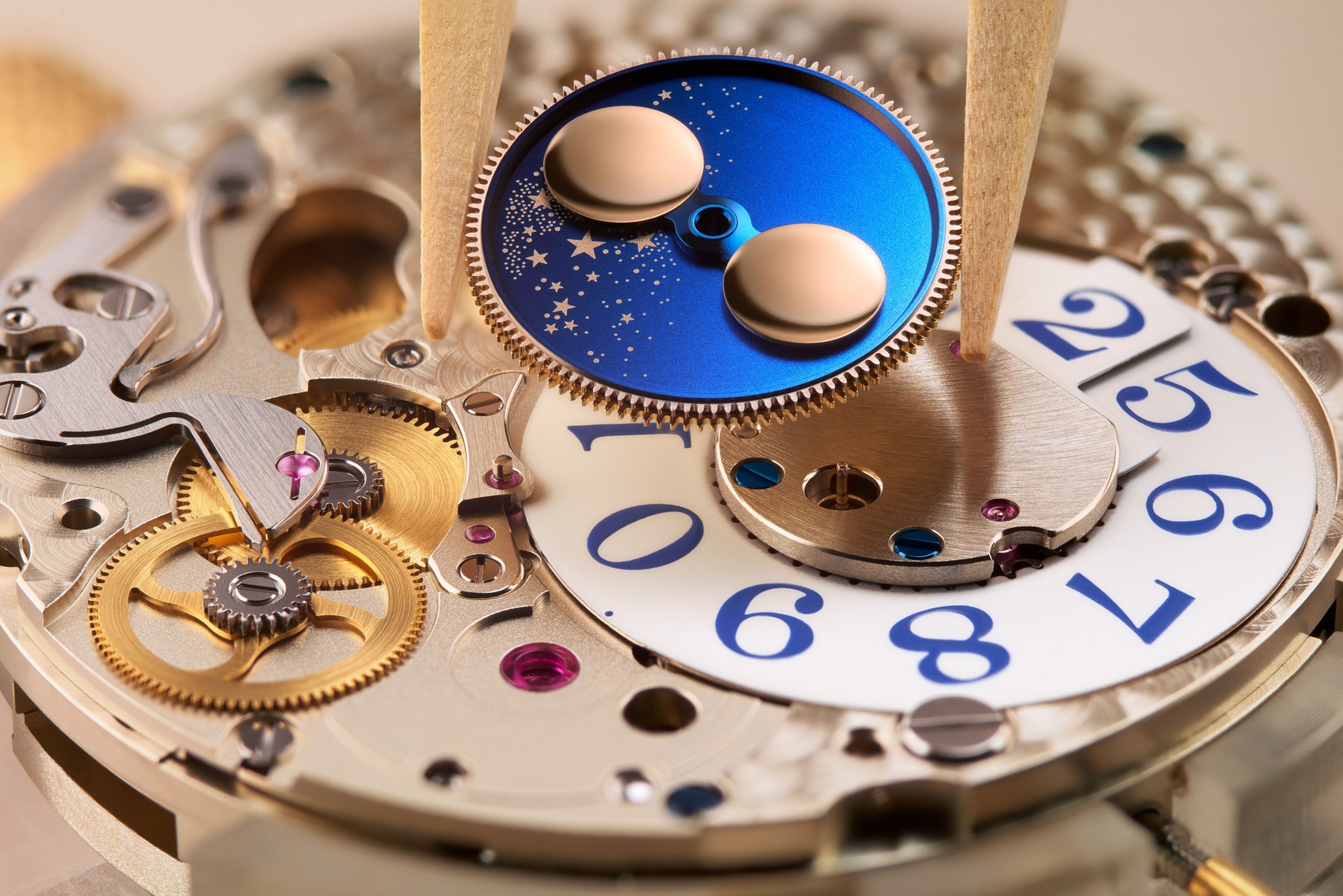Twice is better
Insights into the making of the LANGE 1 MOON PHASE
The LANGE 1 MOON PHASE is shaped by the harmony between 438 components with tolerances of hundredths of a millimetre. It combines the special hallmarks of the classic LANGE 1 with a moon phase indication that only needs to be corrected by one day every 122.6 years and that is complemented by a unique day/night indication, bringing a new dimension to one of the most romantic complications. As like all Lange watches, it is assembled twice.
The moon phase indication is one of the oldest complications in the history of timekeeping devices. Many civilizations before us, such as the ancient Greeks, have tried to understand the moon’s cycles and effects. They built the Antikythera mechanism to observe the movements of the sun and moon. The displays, most of which were scaled as calendars, include a lunar calendar with a monthly scale.
The LANGE 1 MOON PHASE, the first moon phase model of A. Lange & Söhne, was introduced in 2002. Since then, it has become one of the cornerstones of the LANGE 1 family. In 2017, it was endowed with a new calibre named L121.3, combining the moon phase with a day/night indication. As with all Lange models, the double assembly of each watch is a delicate process that requires master craftsmanship.
Twin mainspring barrel assembly
The LANGE 1 was introduced in 1994 with – an unusual feature at this time – a twin mainspring barrel, which was indicated on the dial with the German name “Doppelfederhaus”. This was retained when the model received a newly developed calibre in 2015. The LANGE 1 MOON PHASE features the same basic movement. Each of the two barrels houses a mainspring; together they provide a power reserve of 72 hours. They are assembled to the main plate which is hand-decorated with a perlage finish.
The solarisation technique applied on the surface of the barrels is a reflection of their winding function. The ratchet wheel, which is mounted on each of the barrels, is finished with circular graining (left side of the image). During the first assembly, the watchmaker carves a tiny sign on both barrels to make sure they will be placed back into their correct position during the second assembly.
Assembly of the gear train
Respect for the art of watchmaking in all its aspects is an integral part of A. Lange & Söhne’s philosophy. Even though the parts under the three-quarter plate can never be seen by the owner, all of them are hand-finished with various techniques.
The first assembly of the gear train with its different tiny wheels is a very elaborate process. The teeth of each wheel must mesh perfectly with the teeth of its neighbouring wheels.
Adjustment of endshake
During the first assembly sequence, the watchmaker has to mount and remove the three-quarter plate several times in succession to adjust endshake. To perfectly fit each wheel of the gear train to its teammates, the endshake of each arbor is individually adjusted to run nearly wear-free but precisely. For this, the bearing jewel is pressed into its position in the gold chaton to an accuracy of hundredths of a millimetre. The watchmaker uses a stone setting tool for this time-consuming process which requires a high degree of sensitivity.
Not only the three-quarter plate, but all plates and bridges of Lange timepieces are made of German silver – an alloy composed of copper, zinc and nickel – which is highly valued on account of its favourable properties. The sensitivity of this material to moisture and acids is one of the main reasons for the double assembly. Every fingerprint could produce unsightly blemishes, which is why all Lange watchmakers wear finger cots during the whole assembly process.
Assembly of the three-quarter plate
In between the first and the second assembly, the three-quarter plate is decorated with Glashütte ribbing. All components are cleaned and returned to the watchmaker’s table for the second assembly. The watchmaker polishes the gold chatons and replaces the working screws with new blued steel screws during the second assembly.
The German silver remains untreated and has a beautiful golden hue. The aesthetic effect is particularly desirable because it allows the material to age gracefully, thus highlighting the Glashütte ribbing.
Assembly of the escapement
The last wheel of the gear train is the escape wheel. It is linked to the balance by the lever made of steel. Each lever is individually adapted by adjusting its ruby-stone pallets into their perfect position. From this moment on, the lever cannot be replaced by another one as it is set exactly to this specific watch.
With each semi-oscillation of the balance, the lever is moved back and forth, releasing one tooth of the escape wheel. This, in turn, transfers a precisely defined amount of energy to the oscillation system. Lavishly chamfered edges, sharp corners, grained sides and flat-polished or grinded surfaces require the utmost caution during the assembly.
Assembly of the balance system
The heart of the mechanism – the balance wheel – is assembled to the area which is not covered by the three-quarter plate. The cam-poised balance with a freely oscillating hairspring that was developed in-house and produced by Lange is held in place by a hand-engraved balance cock. Beating with a frequency of 21,600 semi-oscillations per hour, it creates the hearable ticking of the watch.
Adjustment
The movement can be adjusted in five positions. By turning the eccentric poising weights, their mass is shifted as the weight is positioned accordingly – by turning inwards, the balance wheel moves faster and by turning outwards, it slows down. The special tool used has an blade that fits exactly into the slots of the screws.
After the casing has been added, the accuracy of the complete watch is once again checked on an automatic timing apparatus. A. Lange & Söhne movements attain a degree of precision that is at least as high as required for certification by the strict chronometer test.
Assembly of the power reserve mechanism
The components of the power reserve mechanism are assembled on the dial side of the movement and on the base plate which is decorated with a perlage finish. Each of the wheels is lavishly finished with circular graining.
In the photo, the stop lever of the mechanism is being placed. As a result of this arrangement, when the power reserve is depleted exactly after 72 hours. The level of the power reserve is indicated by the UP/DOWN indication on the dial.
Assembly of the outsize date
The outsize date is a signature feature of A. Lange & Söhne. Compared with other watches of comparable size, the display is about three times larger. The framed double aperture design was inspired by the Five-Minute Clock in the Dresden Semper Opera, which was built by Johann Christian Friedrich Gutkaes and Ferdinand Adolph Lange in 1841.
The mechanism relies on two separate display elements: The ring-shaped units disc with the numerals 0 to 9 switches forward once a day. The cross-shaped tens element with the numerals 1 to 3 and a white blank space advances by one increment every ten days only. For the LANGE 1 MOON PHASE “25th Anniversary”, the numerals are printed in blue. The distance between the disc and the tens element that jump at midnight exactly is merely 0.15 millimetres. Great dexterity is needed to assemble this refined mechanism.
Assembly of the moon-phase indication
The 70 parts for the moon-phase display were so cleverly integrated into calibre L121.3 that it is only marginally larger than calibre L121.1 of the LANGE 1. The arrangement of the display is based on two main components. A celestial disc – made of solid gold with a blue coating – performs exactly one revolution every 24 hours. On the disc, the different times of day are represented by varying blue hues caused by interference effects. During the day, it shows a bright sky without stars, while at night it depicts a dark sky with prominently contrasting laser-cut stars. A separate solid-gold moon pursues its orbit in the foreground, thus always circulating against a realistic background that doubles as a day/night indicator when setting the watch. Thanks to a special gear arrangement, the moon is continuously on the move and accurate to 122.6 years.
The disc with the pre-assembled double-moon component is carefully added to the dial side as the last step before the dial is assembled.
Oiling and greasing
During the first assembly, different types of oil and grease are applied to the movement. They all have several additives that deliver the best possible lubrication effect for various applications. There are bearings that must sustain low pressures but high speeds and slowly rotating pinions that carry considerable loads. There are components that must withstand high acceleration and extreme slowness, and others that are exposed to significant levels of friction.
The oils and greases are removed during the cleaning process after the first assembly, so they have to be reapplied during the second assembly. This has to be done according to detailed instructions to assure that none of the 121 oiling and greasing points is forgotten.












